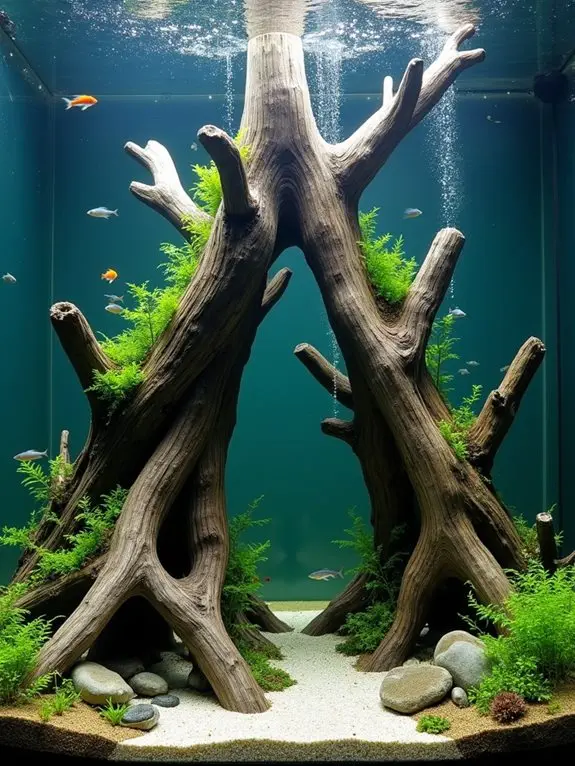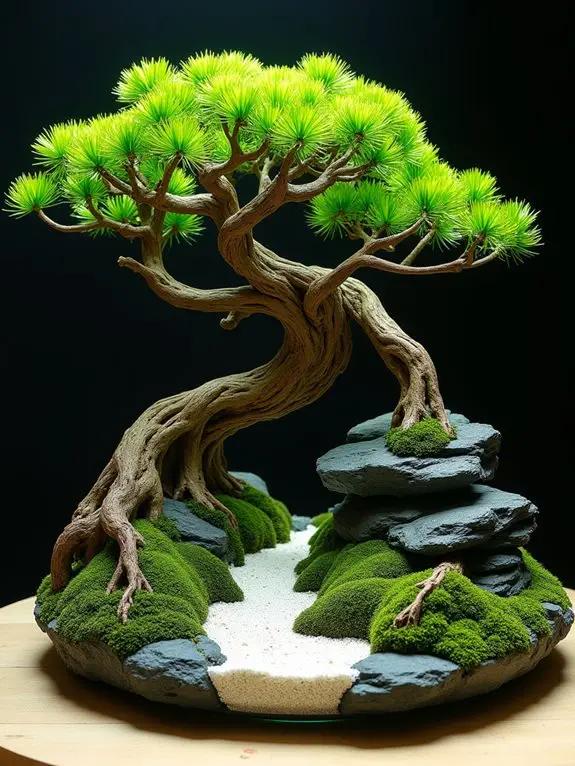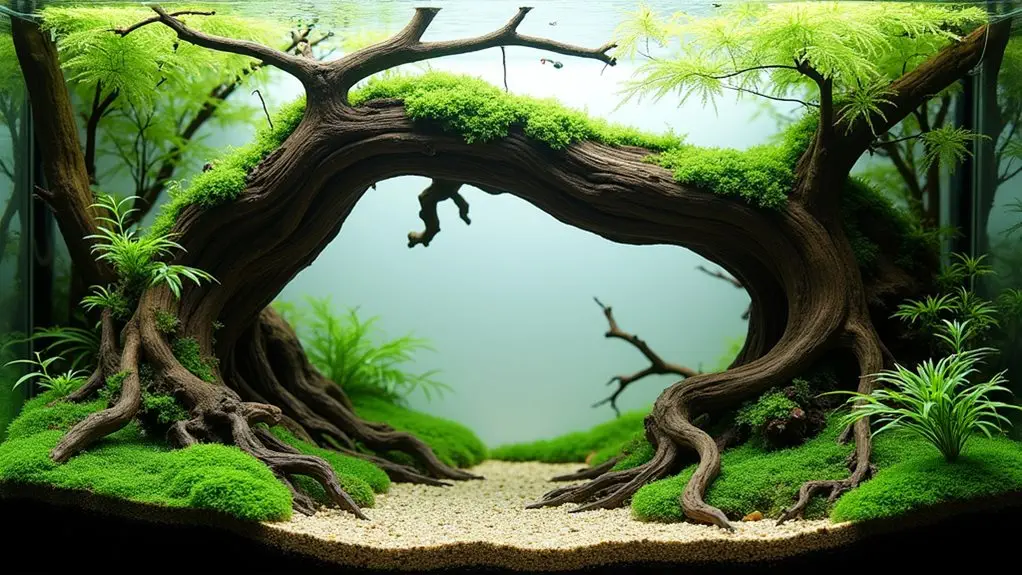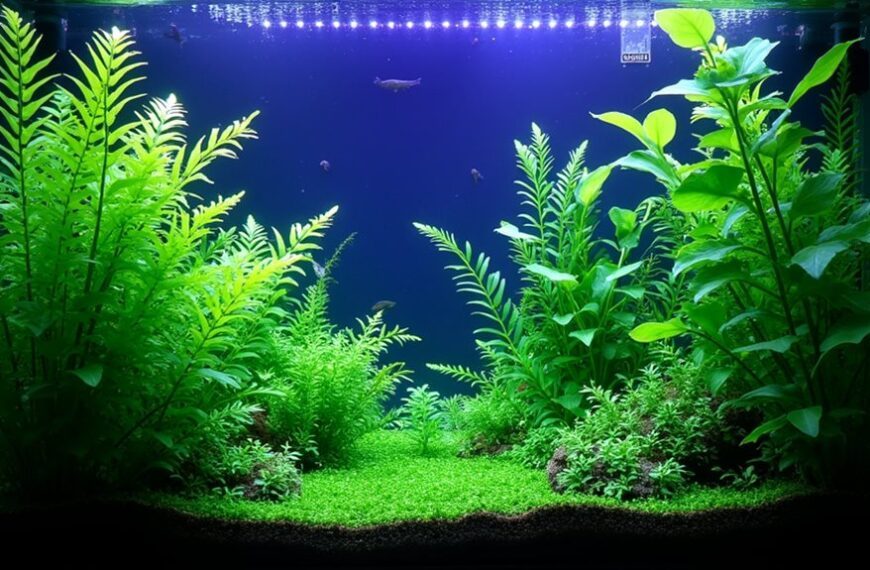To master driftwood aquascaping, select pieces that complement your tank’s dimensions—tall for deeper tanks, horizontal for shallow setups. Thoroughly prepare your wood by scrubbing and soaking until water runs clear, or speed the process by boiling smaller pieces. Create focal points using the triangular method, positioning your largest piece slightly off-center while leaving swimming space. Pair your driftwood with compatible plants like Anubias or Java moss for a lush, natural look. The right balance between wood and other hardscape elements will transform your underwater landscape into a living masterpiece.
Contents
- 1 Selecting the Perfect Driftwood Varieties for Your Aquarium
- 2 Preparation and Treatment Methods for Aquarium Driftwood
- 3 Core Driftwood Arrangement Principles and Layouts
- 4 Integrating Plants and Moss With Driftwood Structures
- 5 Balancing Driftwood With Other Hardscape Elements
- 6 Frequently Asked Questions
- 6.1 How Do I Fix Driftwood That Keeps Floating Despite Soaking?
- 6.2 Can Driftwood Alter My Aquarium’s Ph and Water Hardness?
- 6.3 How Often Should Driftwood Be Replaced or Maintained?
- 6.4 Is Store-Bought Driftwood Safer Than Collected Pieces From Nature?
- 6.5 Can Driftwood Cause Algae Problems in Established Tanks?
- 7 Final Thoughts
Selecting the Perfect Driftwood Varieties for Your Aquarium
Why does choosing the right driftwood make such a difference in your aquascape? It’s the backbone of your underwater landscape, creating both visual focus and natural habitat for your aquatic friends.
When you’re driftwood sourcing, look for pieces that speak to you—twisted branches for dramatic effect or smooth arches for elegant simplicity.
Consider size and shape in relation to your tank dimensions. A tall, vertical piece works wonders in deeper tanks, while horizontally oriented wood maximizes layout potential in shallower setups.
Driftwood aesthetics aren’t just about looks—different varieties offer unique textures and decomposition rates. Spider wood creates delicate branching effects, while mopani provides dense, long-lasting structure.
Malaysian driftwood, with its rich reddish tones, adds warmth to any aquascape.
Preparation and Treatment Methods for Aquarium Driftwood
Before adding that beautiful piece of driftwood to your aquarium, you’ll need to properly prepare it to guarantee it’s safe for your underwater ecosystem. The driftwood curing process isn’t complicated, but it does require patience.
Start by thoroughly scrubbing your driftwood with a stiff brush to remove dirt, loose bark, and potential contaminants.
Next comes the essential driftwood soaking phase, which can take anywhere from a week to several months. Submerge your wood in a container of clean water, changing it every few days until the water remains clear. This removes tannins that would otherwise turn your tank water tea-colored.
For stubborn pieces, try boiling smaller driftwood for 1-2 hours to speed up the process and kill any unwanted hitchhikers hiding in the wood.
Core Driftwood Arrangement Principles and Layouts

Three fundamental principles guide successful driftwood aquascaping: focal point establishment, balance, and negative space utilization.
When selecting and placing your pieces, consider how different driftwood shapes create visual interest. Branchy pieces work beautifully as centerpieces, while twisted roots can add character along the periphery.
For placement techniques, try the triangular method—positioning your largest piece slightly off-center, with smaller pieces creating a natural flow toward it.
Don’t crowd your tank! Remember, the empty spaces between wood are just as important as the driftwood itself. They give fish swimming room and let viewers’ eyes rest.
You’ll know you’ve nailed your layout when it tells a story. Maybe your driftwood resembles a fallen forest or an underwater cave system—let your imagination flow!
Integrating Plants and Moss With Driftwood Structures
Once you’ve established your core driftwood arrangement, adding plants and moss transforms it from merely interesting to absolutely breathtaking.
Consider plant compatibility with your tank conditions before selecting species to complement your driftwood masterpiece.
Carefully match plant selections to your aquarium parameters for a truly successful driftwood-centered aquascape.
- Anubias varieties thrive when attached to driftwood and don’t require substrate
- Java moss creates a lush, natural appearance as it spreads across wood surfaces
- Bucephalandra adds colorful, compact leaf clusters to vertical surfaces
- Christmas moss forms dense, triangular patterns perfect for creating depth
- Microsorum (Java fern) develops dramatic leaves that create striking contrast
When selecting moss for your driftwood, choose varieties that match your maintenance commitment.
You’ll find that some mosses grow quickly, demanding regular trimming, while others develop more slowly, allowing your aquascape to gradually evolve into a living underwater forest.
Balancing Driftwood With Other Hardscape Elements

While plants and moss breathe life into your driftwood arrangement, a truly enchanting aquascape combines multiple hardscape elements that work in harmony. Rocks and stones create natural contrast with driftwood textures, mimicking riverbanks or forest floors.
You’ll want to establish a focal point—typically your largest driftwood piece—and arrange supporting elements to guide the viewer’s eye through your underwater landscape.
Hardscape harmony doesn’t happen by accident. Consider the rule of thirds when positioning your materials, and leave negative space that allows your composition to “breathe.”
Try mixing angular stones with curved driftwood branches, or contrast smooth river rocks with gnarly wood pieces. Remember, nature rarely displays perfect symmetry!
When your hardscape foundation feels balanced yet dynamic, you’ve created the perfect stage for plants to complete your aquatic masterpiece.
Frequently Asked Questions
How Do I Fix Driftwood That Keeps Floating Despite Soaking?
To fix floating driftwood, try these driftwood anchoring techniques: attach it to rocks with fishing line or screws, or weigh it down temporarily. Extend soaking duration methods by using boiling water or longer submersion periods.
Can Driftwood Alter My Aquarium’s Ph and Water Hardness?
Yes, driftwood types can greatly alter your water chemistry. They release tannins that lower pH and soften water. Hardwoods like Malaysian driftwood have stronger effects than lighter varieties, benefiting acidic-water loving fish.
How Often Should Driftwood Be Replaced or Maintained?
You don’t need to replace driftwood regularly. With proper maintenance, it offers impressive longevity—often lasting years. Just clean it occasionally during water changes, removing any debris or algae that accumulates on its surface.
Is Store-Bought Driftwood Safer Than Collected Pieces From Nature?
Store-bought driftwood is typically safer as it’s already treated for aquarium use. You’ll avoid potential contaminants through proper driftwood sourcing. However, if you’re collecting naturally, thorough driftwood treatment is essential before tank introduction.
Can Driftwood Cause Algae Problems in Established Tanks?
Yes, new driftwood can trigger algae growth if not prepared properly. You’ll need to maintain your aquarium balance by curing wood first and monitoring nutrients, as decomposing driftwood algae may release organics into your tank.
Final Thoughts
You’re now ready to create your own underwater masterpiece! With the right driftwood selection, proper preparation, thoughtful arrangement, and strategic plant integration, you’ll transform your aquarium into a living work of art. Remember, there’s no single “correct” approach—your unique vision makes your aquascape special. Don’t be afraid to experiment, adjust, and make it your own. The journey of aquascaping is just as rewarding as the beautiful result!












